The Union Budget seeks to complement macro-economic level growth with a focus on micro-economic level all inclusive welfare. The Union Minister for Finance & Corporate Affairs, Smt Nirmala Sitharaman tabled the Union Budget 2022-23 in Parliament.
Fiscal Management:
- Budget Estimates 2021-22: Rs. 34.83 lakh crore.

- Revised Estimates 2021-22: Rs. 37.70 lakh crore.
- Total expenditure in 2022-23 estimated at Rs. 39.45 lakh crore.
- Total receipts other than borrowings in 2022-23 estimated at Rs. 22.84 lakh crore.
- Fiscal deficit in current year: 6.9% of GDP (against 6.8% in Budget Estimates).
- Fiscal deficit in 2022-23 estimated at 6.4% of GDP.
PART A OF THE BUDGET:
- India’s economic growth is estimated at 9.2% to be the highest among all large economies.
- 60 lakh new jobs to be created under the productivity linked incentive scheme in 14 sectors.
- PLI Schemes have the potential to create an additional production
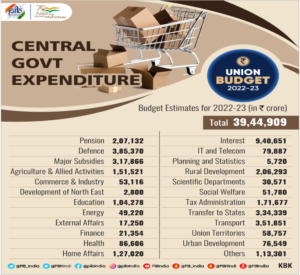 of Rs 30 lakh crore.
of Rs 30 lakh crore.- Entering Amrit Kaal, the 25 year long lead up to India @100,the budget provides impetus for growth along four priorities:
- PM GatiShakti
- Inclusive Development
- Productivity Enhancement & Investment, Sunrise opportunities, Energy Transition, and Climate Action.
- Financing of investments
Goals of Amrit Kaal-
- Focus on growth and all inclusive welfare.
- Promoting technology enabled development, energy transition and climate action.
- Virtuous cycle starting from private investment, crowded in by public capital investment.PM GATISHAKTI-
- It is a transformative approach for economic growth and sustainable development. The approach is drive
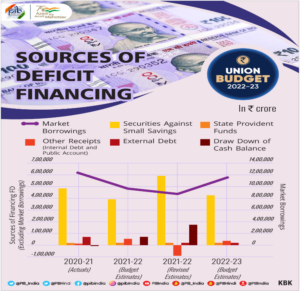 n by seven engines, namely, Roads, Railways, Airports, Ports, Mass Transport, Waterways, and Logistics Infrastructure. PM GatiShakti Master Plan for Expressways will be formulated in 2022-23 to facilitate faster movement of people and goods.
n by seven engines, namely, Roads, Railways, Airports, Ports, Mass Transport, Waterways, and Logistics Infrastructure. PM GatiShakti Master Plan for Expressways will be formulated in 2022-23 to facilitate faster movement of people and goods.
PM Gati Shakti National Master Plan:
- The scope of the Plan will encompass the seven engines for economic transformation, seamless multimodal connectivity and logistics efficiency.
- The projects pertaining to these 7 engines in the National Infrastructure Pipeline will be aligned with PM GatiShakti framework.
Road Transport:
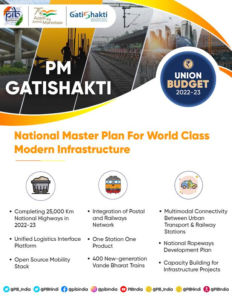
- National Highways Network to be expanded by 25000 Km in 2022-23.
- Rs 20000 Crore to be mobilized for National Highways Network expansion.
Multimodal Logistics Parks:
- Contracts to be awarded through PPP mode in 2022-23 for implementation of Multimodal Logistics Parks at four locations.
Railways:
- One Station One Product concept to help local businesses & supply chains.
- 2000 Km of railway network to be brought under Kavach, the indigenous world class technology and capacity augmentation in 2022-23.
- 400 new generation Vande Bharat Trains to be manufactured during t
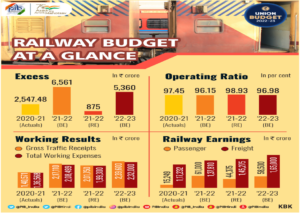 he next three years.
he next three years. - 100 PM GatiShakti Cargo terminals for multimodal
- logistics to be developed during the next three years.
Parvatmala:
- National Ropeways Development Program, Parvatmala to be taken up on PPP mode.
- Contracts to be awarded in 2022-23 for 8 ropeway projects of 60 Km length.
INCLUSIVE DEVELOPMENT-
Agriculture:
- 2.37 lakh crore direct payment to 1.63 crore farmers for procurement of wheat and paddy.
- Chemical free Natural farming to be promoted throughout the county.
- Initial focus is on farmer’s lands in 5 Km wide corridors along river Ganga.

- NABARD to facilitate funds with blended capital to finance startups for agriculture & rural enterprise.
- ‘Kisan Drones’ for crop assessment, digitization of land records, spraying of insecticides and nutrients.
- As 2023 has been announced as the International Year of Millets, the government announced full support for post-harvest value addition, enhancing domestic consumption, and for branding millet products nationally and internationally.
River linking project:
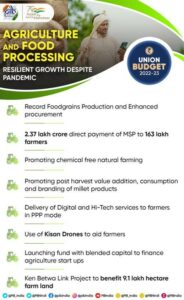
- 1400 crore outlay for implementation of the Ken – Betwa link project.
- 08 lakh hectares of farmers’ lands to receive irrigation benefits by Ken-Betwa link project.
- Draft Detailed Project Reports (DPRs) of five river links, namely Damanganga-Pinjal, Par-Tapi-Narmada, Godavari-Krishna, Krishna-Pennar and Pennar-Cauvery have been finalized and once a consensus is reached among the beneficiary states, the Centre will provide support for implementation.
MSME:
- Udyam, e-shram, NCS and ASEEM portals to be interlinked.
- 130 lakh MSMEs provided additional credit under Emergency Credit Linked Guarantee Scheme (ECLGS).
- ECLGS to be extended up to March 2023.
- Guarantee cover under ECLGS to be expanded by Rs 50000 Crore to total cover of Rs 5 Lakh Crore.
- Rs 2 lakh Crore additional credit for Micro and Small Enterprises to be facilitated under the Credit Guarantee Trust for Micro and Small Enterprises (CGTMSE).
- Raising and Accelerating MSME performance (RAMP) programme with outlay of Rs 6000 Crore to be rolled out.
Education:
- ‘One class-One TV channel’ programme of PM eVIDYA to be expanded to 200 TV channels.
- Virtual labs and skilling e-labs to be set up to promote critical thinking skills and simulated learning environments.
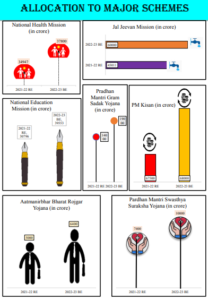 High-quality e-content will be developed for delivery through Digital Teachers.
High-quality e-content will be developed for delivery through Digital Teachers.- Digital University for world-class quality universal education with personalized learning experience to be established.
- Startups will be promoted to facilitate ‘Drone Shakti’ and for Drone-As-A-Service (DrAAS). In select ITIs, in all states, the required courses for skilling will be started.
Health:
- An open platform for the National Digital Health Ecosystem to be rolled out.
- ‘National Tele Mental Health Programme’ for quality mental health counseling and care services to be launched.
- A network of 23 tele-mental health centers of excellence will be set up, with NIMHANS being the nodal center and International Institute of Information Technology-Bangalore (IIITB) providing technology support.
Saksham Anganwadi:
- Integrated benefits to women and children through Mission Shakti, Mission Vatsalya, Saksham Anganwadi and Poshan 2.0.
- Two lakh anganwadis to be upgraded to Saksham Anganwadis.
Water & Housing:
- 60,000 crore allocated to cover 3.8 crore households in 2022-23 under Har Ghar, Nal se Jal.
- 48,000 crore allocated for completion of 80 lakh houses in 2022-23 under PM Awas Yojana.
Prime Minister’s Development Initiative for North-East Region (PM-DevINE):
- New scheme PM-DevINE launched to fund infrastructure and social development projects in the North-East.
- An initial allocation of Rs. 1,500 crore was made to enable livelihood activities for youth and women under the scheme.
Vibrant Villages Programme:
- Vibrant Villages Programme for development of Border villages with sparse population, limited connectivity and infrastructure on the northern border.
Banking:
- 100 percent of 1.5 lakh post offices to come on the core banking system.
- Scheduled Commercial Banks to set up 75 Digital Banking Units (DBUs) in 75 districts to mark 75 years of independence.
PRODUCTIVITY ENHANCEMENT & INVESTMENT, SUNRISE OPPORTUNITIES, ENERGY TRANSITION, AND CLIMATE ACTION
- The issuance of e-Passports using embedded chip and futuristic technology will be rolled out in 2022-23 to enhance convenience for the citizens in their overseas travel
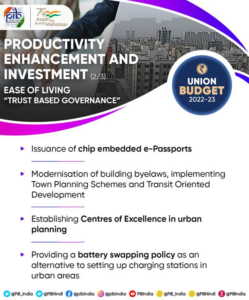
- Centre for Processing Accelerated Corporate Exit (C-PACE) to be established for speedy winding-up of companies.
Export Promotion:
- Special Economic Zones Act to be replaced with a new legislation to enable States to become partners in ‘Development of Enterprise and Service Hubs’.
AtmaNirbharta in Defence:
- 68% of the capital procurement budget earmarked for domestic industry in 2022-23, up from 58% in 2021-22.
- Defense R&D to be opened up for industry, startups and academia with 25% of defense R&D budget earmarked.
- Independent nodal umbrella body to be set up for meeting testing and certification requirements
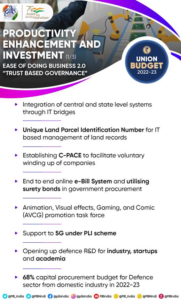
Sunrise Opportunities:
- Government contribution to be provided for R&D in Sunrise Opportunities like Artificial Intelligence, Geospatial Systems and Drones, Semiconductor and its ecosystem, Space Economy, Genomics and Pharmaceuticals, Green Energy, and Clean Mobility Systems.
Energy Transition and Climate Action:
- Additional allocation of Rs. 19,500 crores for Production Linked Incentive for manufacture of high efficiency solar modules to meet the goal of 280 GW of installed solar power by 2030.
- Five to seven per cent biomass pellets to be co-fired in thermal power plants:
- CO2 savings of 38 MMT annually,
- Extra income to farmers and job opportunities to locals,
- Help avoid stubble burning in agriculture fields.
- Four pilot projects to be set up for coal gasification and conversion of coal into chemicals for the industry.
- Financial support to farmers belonging to Scheduled Castes and Scheduled Tribes, who want to take up agro-forestry.
Public Capital Investment:
- Public investment to continue to pump-prime private investment and demand in 2022-23.
- Outlay for capital expenditure stepped up sharply by 35.4% to Rs. 7.50 lakh crore in 2022-23 from Rs. 5.54 lakh crore in the current year.
- Outlay in 2022-23 to be 2.9% of GDP.
- ‘Effective Capital Expenditure’ of the Central Government is estimated at Rs. 10.68 lakh crore in 2022-23, which is about 4.1% of GDP.
GIFT-IFSC:
- World-class foreign universities and institutions to be allowed in the GIFT City.
- An International Arbitration Center to be set up for timely settlement of disputes under international jurisprudence.
Mobilizing Resources
- Data Centers and Energy Storage Systems to be given infrastructure status.
- Venture Capital and Private Equity invested more than Rs. 5.5 lakh crore last year facilitating one of the largest start-up and growth ecosystems. Measures to be taken to help scale up this investment.
- Blended funds to be promoted for sunrise sectors.
- Sovereign Green Bonds to be issued for mobilizing resources for green infrastructure.
Digital Rupee:
- Introduction of Digital Rupee by the Reserve Bank of India starting 2022-23.
Financing of Investments- Providing Greater Fiscal Space to States:
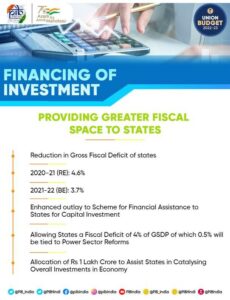
- Enhanced outlay for ‘Scheme for Financial Assistance to States for Capital Investment’:
- From Rs. 10,000 crore in Budget Estimates to Rs. 15,000 crore in Revised Estimates for the current year.
- Allocation of 1 lakh crore in 2022-23 to assist the states in catalyzing overall investments in the economy: fifty-year interest free loans, over and above normal borrowings.
- In 2022-23, States will be allowed a fiscal deficit of 4% of GSDP, of which 0.5% will be tied to power sector reforms.
PART B OF THE BUDGET
- The Union Budget 2022-23, while continuing with the declared policy of stable and predictable tax regime, intends to bring more reforms that will take ahead the vision to establish a trustworthy tax regime.
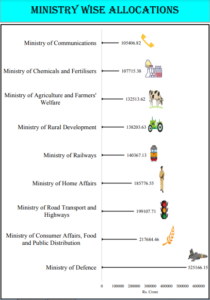
DIRECT TAXES:
Following are the various proposals made under the direct taxes in this Budget:
Introducing new ‘Updated return’& other reliefs:
- The budget allows taxpayers to file updated income tax returns within 2 years for correcting errors.
- It will enable the assessee to declare income missed out earlier.
- The parent or guardian of a differently-abled person can take an insurance scheme for such a person.
- The present law provides for deduction to the parent or guardian only if the lump sum payment or annuity is available to the differently abled person on the death of the subscriber i.e. parent or guardian.
- The budget now allows the payment of annuity and lump sum amount to the differently abled dependent during the lifetime of parents/guardians, i.e., on parents/ guardians attaining the age of sixty years.
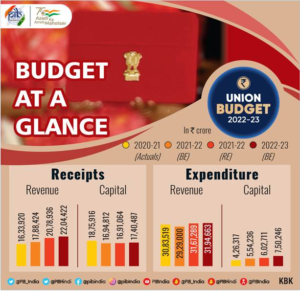
Cooperative societies:
- The budget also reduces Alternate minimum tax rate and surcharge for cooperatives from 18.5 percent to 15 percent.
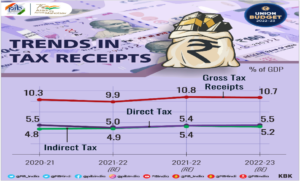
- Surcharge on cooperative societies reduced from 12 percent to 7 percent for those having total income of more than Rs 1 crore and up to Rs 10 crores.
Parity in National Pension Scheme Contribution:
- The Central Government contributes 14 per cent of the salary of its employees to the National Pension System (NPS) Tier-I.
- This is allowed as a deduction in computing the income of the employee. However, such deduction is allowed only to the extent of 10 percent of the salary in case of employees of the State government.
- To provide equal treatment, the budget proposes to increase the tax deduction limit from 10 percent to 14 percent on employer’s contribution to the NPS account of State Government employees as well.
Incentives for Start-ups & other incentives:
- Eligible start-ups established before 31.3.2022 had been provided a tax incentive for three consecutive years out of ten years from incorporation.
- In view of the Covid pandemic, the budget provides for extending the period of incorporation of the eligible start-up by one more year, that is, up to 31.03.2023 for providing such tax incentive.
- The Union Budget proposes to extend the last date for commencement of manufacturing or production under section 115 BAB by one year i.e. to 31st March, 2024.
Scheme for taxation of virtual digital assets:
- Specific tax regime for virtual digital assets introduced.
- Any income from transfer of any virtual digital asset to be taxed at the rate of 30 per cent.
- No deduction in respect of any expenditure or allowance to be allowed while computing such income except cost of acquisition.
- Loss from transfer of virtual digital assets cannot be set off against any other income.
- To capture the transaction details, TDS to be provided on payment made in relation to transfer of virtual digital assets at the rate of 1 percent of such consideration above a monetary threshold.
- Gift of virtual digital assets also to be taxed in the hands of the recipient.
Litigation Management & Tax incentives to IFSC
- The budget provides that, if a question of law in the case of an assessee is identical to a question of law which is pending in appeal before the jurisdictional High Court or the Supreme Court in any case, the filing of further appeal in the case of this assessee by the department shall be deferred till such question of law is decided by the jurisdictional High Court or the Supreme Court.
- It has been proposed in the budget that income of a non-resident from offshore derivative instruments, or over the counter derivatives issued by an offshore banking unit, income from royalty and interest on account of lease of ship and income received from portfolio management services in IFSC shall be exempt from tax, subject to specified conditions, the following to be exempt from tax:
- Income of a non-resident from offshore derivative instruments.
- Income from over the counter derivatives issued by an offshore banking unit.
- Income from royalty and interest on account of lease of ship.
- Income received from portfolio management services in IFSC.
Other tax proposals
- Surcharge on AOPs (consortium formed to execute a contract) capped at 15 per cent.
- Rationalization of Surcharge was done to reduce the disparity in surcharge between individual companies and AOPs.
- Surcharge on long term capital gains arising on transfer of any type of assets capped at 15 per cent.
- Any surcharge or cess on income and profits not allowable as business expenditure.
- No set off of any loss to be allowed against undisclosed income detected during search and survey operations.
- Tax deduction provided to the person giving benefits, if the aggregate value of such benefits exceeds Rs 20,000 during the financial year.
INDIRECT TAXES
- On the Indirect tax side, the Union budget says that Customs Administration of SEZs to be fully IT driven and function on the Customs National Portal – shall be implemented by 30th September 2022.
- Gradually phasing out of the concessional rates in capital goods and project imports; and applying a moderate tariff of 7.5 percent – conducive to the growth of the domestic sector and ‘Make in India’.
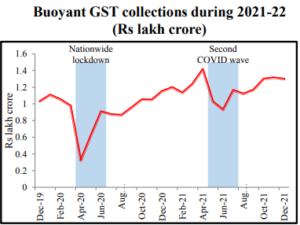
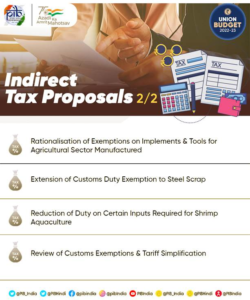
- Certain exemptions for advanced machineries that are not manufactured within the country shall continue.
- A few exemptions were introduced on inputs, like specialized castings, ball screw and linear motion guide – to encourage domestic manufacturing of capital goods.
- More than 350 exemption entries proposed to be gradually phased out, like exemption on certain agricultural produce, chemicals, fabrics, medical devices, & drugs and medicines for which sufficient domestic capacity exists.
- Simplifying the Customs rate and tariff structure particularly for sectors like chemicals, textiles and metals and minimize disputes; Removal of exemption on items which are or can be manufactured in India and providing concessional duties on raw material that go into manufacturing of intermediate products – in line with the objective of ‘Make in India’ and ‘Atmanirbhar Bharat’.
Sector specific proposals
- In the field of electronics, Customs duty rates are being calibrated to provide a graded rate structure to facilitate domestic manufacturing of wearable devices, hearable devices and electronic smart meters.
- Duty concessions are also being given to parts of the transformer of mobile phone chargers and camera lens of mobile camera module and certain other items.
- To give a boost to the Gems and Jewellery sector, Customs duty on cut and polished diamonds and gemstones is being reduced to 5 per cent.
- To facilitate export of jewellery through e-commerce, a simplified regulatory framework shall be implemented by June this year.
- To disincentive import of undervalued imitation jewellery, the customs duty on imitation jewellery is being prescribed in a manner that a duty of at least Rs 400 per Kg is paid on its import.
- Customs duty on certain critical chemicals namely methanol, acetic acid and heavy feed stocks for petroleum refining are being reduced, while duty is being raised on sodium cyanide for which adequate domestic capacity exists.
- Duty on umbrellas is being raised to 20 per cent. Exemption to parts of umbrellas is being withdrawn.
- Exemption is also being rationalised on implements and tools for agri-sectors which are manufactured in India.
- Customs duty exemption given to steel scrap last year is being extended for another year. Certain Anti- dumping and CVD on stainless steel and coated steel flat products, bars of alloy steel and high-speed steel are being revoked.
- To incentivise exports, exemptions are being provided on items such as embellishment, trimming, fasteners, buttons, zipper, lining material, specified leather, furniture fittings and packaging boxes that may be needed by bonafide exporters of handicrafts, textiles and leather garments, leather footwear and other goods. Duty is being reduced on certain inputs required for shrimp aquaculture so as to promote its exports.
- To encourage the efforts for blending of fuel, unblended fuel shall attract an additional differential excise duty of Rs 2/ litre from the 1st day of October 2022.
Budget Documents:
The list of Budget documents presented to the Parliament, besides the Finance Minister’s Budget Speech are : A. Annual Financial Statement (AFS), B. Demands for Grants (DG), C. Finance Bill, D. Fiscal Policy Statements mandated under FRBM Act(i. Macro-Economic Framework Statement. ii. Medium-Term Fiscal Policy cum Fiscal Policy Strategy Statement), E. Expenditure Budget, F. Receipt Budget, G. Expenditure Profile, H. Budget at a Glance, I. Memorandum Explaining the Provisions in the Finance Bill, J. Output Outcome Monitoring Framework, K. Key Features of Budget 2022-23, L. Implementation of Budget Announcements, 2021-2022.
Details of these documents-
- The documents shown at Serial Nos. A, B, and C are mandated by Art. 112,113 and 110(a) of the Constitution of India respectively, while the documents at Serial No. D(i) and (ii) are presented as per the provisions of the Fiscal Responsibility and Budget Management Act, 2003.
- The “Output Outcome Monitoring Framework” will have clearly defined outputs and outcomes for various Central Sector Schemes and Centrally Sponsored Schemes with measurable indicators against them and specific targets for FY 2022-23.
- The Annual Financial Statement (AFS), the document as provided under Article 112, shows the estimated receipts and expenditure of the Government of India for 2022-23 along with estimates for 2021-22 as also actuals for the year 2020-21.
- The receipts and disbursements are shown under three parts in which Government Accounts are kept viz., (i) The Consolidated Fund of India, (ii) The Contingency Fund of India and (iii) The Public Account of India.
- The Annual Financial Statement distinguishes the expenditure on revenue account from the expenditure on other accounts, as is mandated in the Constitution of India. The Revenue and the Capital sections together, make the Union Budget.
- The estimates of receipts and expenditure included in the Annual Financial Statement are net of refunds and recoveries respectively.
- Article 113 of the Constitution mandates that the estimates of expenditure from the Consolidated Fund of India included in the Annual Financial Statement and required to be voted by the Lok Sabha, be submitted in the form of Demands for Grants.
- The Demands for Grants are presented to the Lok Sabha along with the Annual Financial Statement.
- At the time of presentation of the Annual Financial Statement before the Parliament, a Finance Bill is also presented in fulfillment of the requirement of Article 110 (1)(a) of the Constitution, detailing the imposition, abolition, remission, alteration or regulation of taxes proposed in the Budget.
- It also contains other provisions relating to the Budget that could be classified as Money Bill. A Finance Bill is a Money Bill as defined in Article 110 of the Constitution.
- The Union Budget 2022-2023 has declared a major revamping / ‘rationalisation’ of centrally sponsored schemes (CSS). CSSs are totally funded by the central government but implemented by states. In the Budget 2022-2023, the government allocated Rs 4,42,781.19 crore for such schemes. According to the Budget document, 130 CSSs spanning all ministries have been “rationalised / revamped” into 65 schemes ((CSSs declared after April 1, 2020 have not been included in the list)).
The Union Ministry of Women and Child Development that had 19 CSSs is left with only three:
- Mission Shakti— has subsumed 14 schemes, including Beti Badhao, Beti Padhao
- Mission Vatsalya
- Saksham Anganwadi and POSHAN 2.0
- Under the Ministry of Animal Husbandry and Dairying, 12 CSSs have been revamped into two schemes; three have been shut down.
- The two news schemes are Infrastructure Development Fund and Development programmes (Animal Husbandry).
- The three to be closed are Dairying Through Cooperatives, National Dairy Plan-II and National Dairy Plan.
The Ministry of Agriculture and Farmers’ Welfare has the highest toll — 20 CSSs have been rationalised into three schemes:
- Krishionati Yojana
- Integrated Scheme on Agricultural Cooperative
- Rashtriya Krishi Vikas Yojana
- The National Project on agro-forestry has been “subsumed in other CSS.”
- The National Project on Organic Farming has been “moved to Establishment Expenditure”.
















